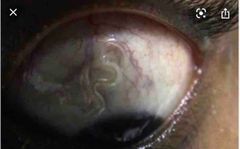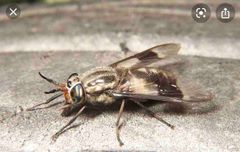![]()
![]()
![]()
Use LEFT and RIGHT arrow keys to navigate between flashcards;
Use UP and DOWN arrow keys to flip the card;
H to show hint;
A reads text to speech;
8 Cards in this Set
- Front
- Back
|
Epidemiology |
Forest areas In West and Central Africa (Cameroon) Transmitted by Chrysops deer fly |
|
|
Clinical features |
Calabar swellings where adult worms are Migrate across the eye Cause urticaria, rashes, itching, pain Can cause chronicity but less common |
|
|
Diagnosis |
Microfilaria in mid day blood PCR – diagnostic Serology- non-specific for type of filaria Eye worms are diagnostic |
|
|
Treatment |
Risk versus benefit needs to be evaluated High risk of encephalitis If give ivermectin When you have a high microfilariae load DEC can also cause encephalopathy if there is a high load (more than 1000 MF per ml) If less than 2500 then DEC can be Divided into three times a day regime If More than 2500 then give albendazole For 21 days to reduce the load followed by DEC Doxy not effective
|
|
|
Skin Sampling |
Skin snip - used to look for microfilariae off onchocerciasis Skin smear - From the ear lobe for leprosy Skin smear of lesion or needle biopsy – test for leishmaniasis |
|

Front (Term) |
Loa loa |
|

Front (Term) |
Deer fly |
|

Front (Term) |
Loa loa microfilaria |

